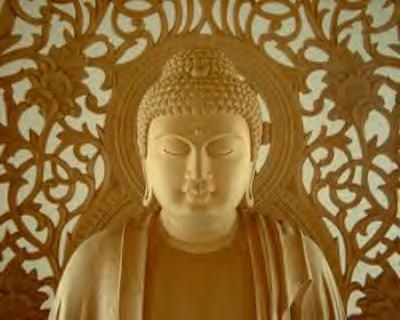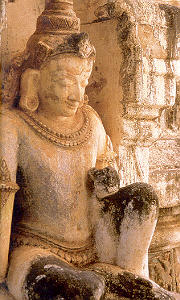As well as the discipline of meditation, the hinayana also stresses the importance of postmeditation discipline. Discipline in Sanskrit is shila, and in Tibetan it is tsultrim (tshul-khrims). Tsul means "proper" or "appropriate"; trim means "regulation," "law," or "norm." So tsultrim is practicing "proper conduct" or "proper discipline," according to the example of the Buddha.
During his lifetime, the Buddha established disciplinary rules of conduct that are strictly applied in monastic life. These are called the vinaya in Sanskrit, or dulwa ('dul-ba) in Tibetan. Both vinaya and dulwa literally mean "taming." So in general, vinaya can be understood as any discipline that we practice in order to tame our being.
In the hinayana, the only way to conduct ourselves is according to the message of vinaya, the message of discipline. Through practicing the proper conduct of tsultrim, our body, speech, and mind are thoroughly tamed, and we are able to quell, or cool off, the heat of neurosis. Because of that, we are able to practice the greater hinayana discipline of not causing harm to ourselves and others. And finally, based on practicing such total discipline, we are able to achieve what is called "individual liberation" (Sanskrit pratimoksha, Tibetan so-sor-tharpa). Individual liberation is a tremendous accomplishment, which enables us to express our basic goodness as human beings.
The mahayana, or "great vehicle," is like a wide, open highway in contrast to the narrow path of hinayana discipline. The mahayana goes beyond the hinayana ideal of individual liberation alone. Its aim is the liberation of all sentient beings, which means that everyone, everything, is included in the vast vision of mahayana. All the chaos and confusion and suffering of ourselves and others is part of the path.
The primary discipline of the mahayana is helping others, putting others before ourselves. The training of the mahayana practitioner is to exchange himself for others. As a well-known mahayana slogan puts it: "Gain and victory to others; loss and defeat to oneself." However, it should be clear that this attitude is not based on self-denial or martyrdom, but rather springs from the development of genuine warmth and compassion. Thus, the mahayana is expansive and embracing.
The third yana, the vajrayana, literally means the "diamond or indestructible vehicle." The idea of indestructibility here is the discovery of indestructible wakefulness, the discovery of our own innate awakened state of mind, or vajra nature. Since this book deals with the vajrayana teachings, it seems unnecessary to explain too much about them here. However, it is extremely important to understand at the outset that the vajrayana is a continuation of the previous two yanas and that without proper training in the hinayana and mahayana disciplines, it is impossible to step onto the tantric path.
Tantra literally means "continuity" or "thread." Hinayana, mahayana, and vajrayana are a continuous thread of sympathy and sanity, which is never broken. Vajrayana is further and greater expansion. It is the expression of greater sanity and greater sympathy, arising from the practice of hinayana and mahayana.
Throughout this book the reader will find numerous warnings about the dangers of vajrayana and the importance of beginning at the beginning--with the practice of meditation.
-----
Journey Without Goal, Chogyam Trungpa, introduction
-----
I see! (said the blind man)
This is from a master of Tantric Tibetan Buddhism, whom my unkle and aunt used to run a meditation center for.
I like how it is stressed that basic level one: meditation is the first step, then compassion for all, then finally after those the vajrayana path is possible. Vajra means diamond and tantra teaches an indestructible, diamondlike awareness. This type of tantra is not the sexual kind at all, rather the most detached type of Buddhism.
I realize this OMWORK from Trungpa's books is truly mind-bending
When you see the other posts from this book you'll see why meditating is the first step, your brain will need hardening to deal with the egolessness coming up.. really!!!
So after 7 years of meditating 2-4 hours a day you can continue to the next posts.. he he.. well at least know that when the brain is overloaded, meditation is the medication! Teo Dr's prescription for health. Take two Oms and call me in the morning.. he he..
Love n light, Teo



